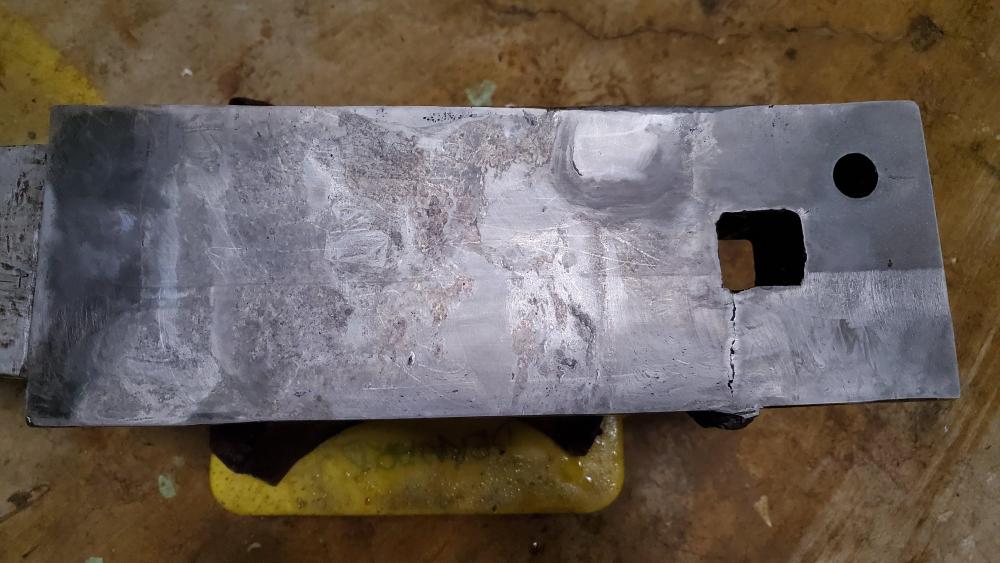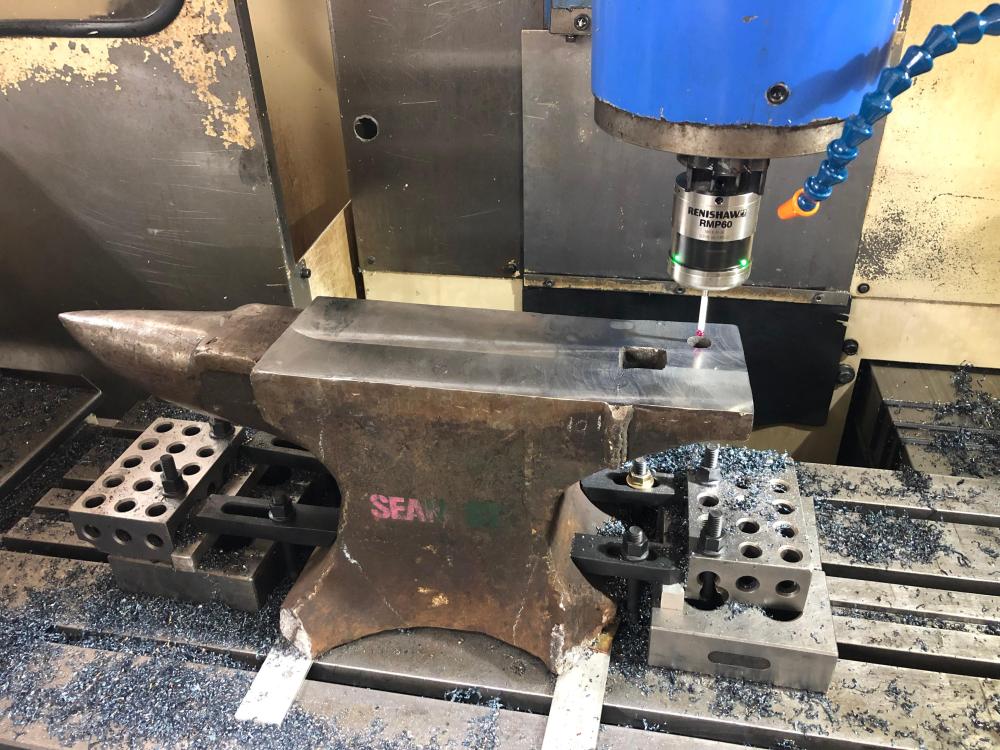
Trilliumforge
-
Posts
59 -
Joined
-
Last visited
Content Type
Profiles
Forums
Articles
Gallery
Downloads
Events
Posts posted by Trilliumforge
-
-
I'm also considering leaving it as is. The average rebound is 50-60% (no real change from before milling), and it's about the same as a mousehole I have that is still a great anvil. For how I use it having the face flat was more important to me than how hard the face is, worst case scenario I save it for detail work instead of heavy forging.
-
Update, I have the anvil back and I'm very happy with my decision to have the face milled. From what he said, I was right that there was virtually no steel on the anvil face, apart from just before the horn. I cleaned and polished the face, then etched it with ferric chloride to show the structure of the face. The wrought iron in the body has a lot of slag and it's grain structure is huge. I also see a crack near the horn and the extent of the crack in the heel. I've known for a long time this anvil was in bad shape, but I'm happy to learn what I've learned through the process. I'm still working out how I will reface it, but I'll post when I do.
-
To be clear, the anvil I had milled had lost nearly all of its face and was down to the wrought iron, which is why I didn't go with welding on hard facing initially. Also this project isn't about getting sharp corners, it's about have a working surface on the anvil in the first place.
I'm going to continue with this method of replacing the face as it was explained to me, with the d2 plate welded around the sides with very flat surfaces in contact. I'll post updates as I go, so at least if this is a complete bust I can give a clear description of why it didn't work.
Thanks for the input!
-
Can you link me to the Gunther/Schuler process you mentioned? I'm planning on tack welding the d2 plate to the face, then heating the whole thing up before finishing the weld with a heavy duty stick welder (still deciding on what the best rod to use is).
-
Thanks everyone, that's great!
-
Hey all,
I'm very lucky to have a friend with an industrial mill. My anvil is an old one from a junk yard that had been very badly treated, no makers marks but it's wrought iron with most of the top face ground down. The top face was actually convex which meant that any time I tried to use a punch the piece I was working on would spin around. I'll be refacing it with a 3/4" D2 plate, and if all goes well it should be good for another few hundred years
Brace yourselves, this may be the sexiest thing I've ever seen.
Cheers,
Sean
-
Hi all! Does anyone out there have patterns or templates for making a betty lamp? I figured I'd ask before I started reinventing the wheel. I'm thinking of something like this:

-
Hi folks,
What are people's thoughts about clinker breaker shape? I've ususally seen clinker breakers that are triangular, but on occasion square blocks. Any advantages of one over the other? I can imagine that a square block would be a lot easier to make, but do they work as well? Why is triangular more common?
SEan
-
-
-
Usually I just do it by hand, but what can help is after you stretch out the hole, tap it down over a cone hardy to make the hole as round as possible. Then just tap it gently straight back towards yourself, off the anvil. Does that make sense?
-
Thanks for moving the thread. I thought there was a shop building section, but I couldn't find it.
I'm in Southern Ontario, and 108 square foot is the biggest you can go without a permit. I'm not planning on building one anytime soon, but I was just thinking about it in general. I'm really thinking about how could you best use that space, not how to setup a new shop for any particular kind of work.
Maybe it shouldn't be square?
-
VaughnT, I did a search for Pughman's build, but I didn't find anything. Do you know where I can find it?
-
Hey folks,
I was just looking at my local buiding codes... and it got me thinking about how you would lay out a 10'x10' shed forge. Any ideas?
Sean
-
-
One of the big reasons I want to make a new firepot is to have one with a clinker breaker. Any advice on making a clinker breaker from scratch?
-
Hi folks,
I'm thinking of making a firepot for my portable forge, and I was hoping for some advice. I've seen some for sale that look good, but which are a bit too heavy for my portable unit. I'd like to fabricate something, but I'm wondering about thickness. How thin can the walls of my fire pot be? Could I make it out of 1/4" plate? 3/8" plate? I really want to keep the weight down, but I don't want it to burn through on me either.
Any suggestions?
-
-
-
Does anyone know the original colours for a Canadian Forge and Blower hand crank blower? I'm not looking to change what I've done already, I'm just curious as to what the originals would look like.
-
Hi folks,
I'm doing a clean up on my blower, a small one from Canadian Blower and Forge. I've repainted the outside, but I'm wondering if I should paint inside where the fan blade goes. I'm trying to give it some rust protection, as I mostly use it outside, and last time I took it out it got pretty rusty. I'm not going to paint inside where the gears are, but I'm wondering if there's any downside to painting in with the fan. I can imagine some of it chipping off, but then it would just blow out, so I don't see the harm. Any thoughts?

Sean
-
Thanks, that's a big help! I might see about going for the Magestic forge, I like the idea of independant controls on the burners. Should I reline with itc-100 when I get it?
-
Can you tell me a bit about them? How are they on fuel? Welding? I was looking at the 2 Burner Artist Deluxe Forge, any thoughts?
-
Is anyone out there using a Whisper Baby?




















Trying to decide on how to do a different finish on two parts of a celtic knot
in Finishes for Metal
Posted
Hi everyone,
I've been working on this backplate for a coat rack through covid as an on-and-off time killer. So far I've chiseled, cut, drilled, filed, chased, carved, chiseled, undercut, inlaid, re-inlaid, re-re-re-inlaid, sanded, and brushed to get to this point. I've been considering a number of different finishes for each of the two ribbons of the knot; like now but buffed with a bit of steel wool, tempering brown, tempering blue, brushing with acid then oiling, etc. I've also looked at a few of the finishes from sculptnouveau.com, but I can't use any of the hot finishes because I'm worried about thermal expansion damaging the copper inlay. I'm not too worried about that with the tempering finished because the effect would be on a much smaller scale, but I won't be running this through a forge again. I'm also not sure if I want the ribbon with the copper inlay to be lighter or darker than the snake. I can imagine this looking good in a few different ways, but I need to make up my mind on which to go with.
Thanks!